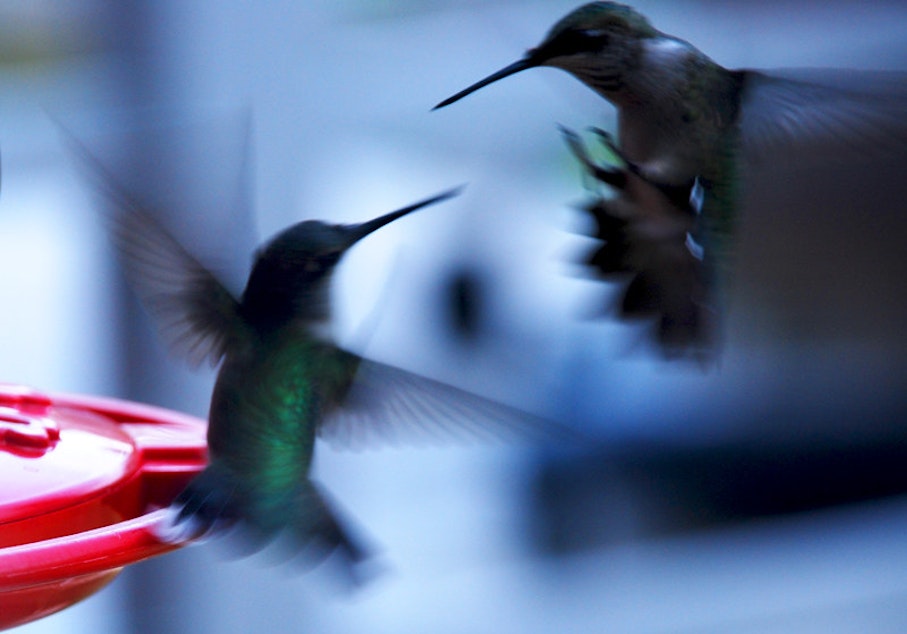Angry birds: Hummingbirds are cute, but they’re primed to fight

At first, I didn't know what I was seeing — a tiny blur at the edge of a bush in Seattle's Wedgwood neighborhood, from which emitted a dramatic, high-pitched scream.
Then the scene became clear: Two hummingbirds were brawling, violently, think barroom at 1 a.m. And one was clearly losing.
Hummingbirds, I realized, are not just adorable. They're also jerks.
Yes, jerks. But don't take my word for it.
“'Hummingbirds are jerks' is a pretty good tagline for how hummingbirds operate. I use that word a lot to describe them. They fight all the time," said Alyssa Sargent, a PhD candidate at the University of Washington working in the behavioral ecophysics lab.
RELATED: UW researcher slows down hummingbirds to study them. What he found is amazing
I witnessed the ultimate victor bashing its foe into the ground as it held on with its feet, stabbing its competitor with its needle-like beak the entire time.
It was a sobering moment. Should I have broken up the fight? Perhaps offered each bird complimentary nectar and let them chirp out their woes until they calmed down?
"Trying to break up a hummingbird fight, you’d be fighting a losing battle there," Sargent said.
Sure, hummingbirds are renowned for their beauty and rapid, graceful flight. They are a treat in any garden and are generally greeted with joy.
"Hummingbirds are so fast, that when they fight, most of the time you see a blur," said Alejo Rico-Guevara, an assistance professor at UW's Department of Biology, and also curator of birds at the Burke Museum.
"You often see them when they are calmly dipping their head down at a feeder, and sitting in branches," Rico-Guevara said. "You may not realize they're keeping a bubble around themselves. And the way to keep that bubble is by chasing others, very fiercely, away from their territories."
In my case, one hummingbird likely bellied up to a flower, and another didn't like that so much. One started chirping. The other took umbridge. A fight ensued until they were both on the ground.
I walked away as the victor flew higher, and the other stayed grounded. I'm sorry to say, I don't know it fared.
This encounter is not an anomaly.
Escalation tactics
For researchers like Rico-Guevara and Sargent, who watch these birds for a living, such aggression is a trait that spans the species.
RELATED: Female hummingbirds are mimicking males to avoid aggression
To us, hummingbirds appear to glide serenely from flower to flower. But from the hummingbirds' perspective, they're living in a "Mad Max" hellscape, in a manic competition for resources.
Still, the interaction witnessed in Seattle is not too common around Washington state. Rico-Guevara said most aggressive hummingbird behavior starts, and ends, with words.
“Most of the times it's subtle, they don't want to just go on to full battle," Rico-Guevara said. "They usually start by yelling at each other. They have very sharp vocalizations."
But it might escalate. "You can see them going all the way to the floor, spiraling," Rico-Guevara said.
Hummingbirds are constantly hunting for food. Their metabolism is so fast, their movements are so rapid, they require considerable energy to survive.
And each flower has only so much nectar. If a hummingbird arrives second to the flower, there may not be much left. Queue the fight
Males are the fighters of the species, with bills strong enough for battle. Female bills are more blunt and soft.
"It's easy to think of hummingbirds as these cute, graceful, adorable animals, right … they're the world's smallest birds. They're beautiful," Sargent said. "We have really interesting names for them — Sun Angel, Emerald, Amethyst ... and they drink mostly sugar water, so it's a recipe for a really charismatic animal. But yeah, they do spend a lot of their time fighting … and some of them have weaponized bills, which they use to basically stab and attack each other … it’s like a sword, almost.”
Hummingbirds: Garden warriors
To be fair, by human standards, hummingbirds may be "jerks." By hummingbird standards, they're behaving how nature has programmed them.
The fact that hummingbirds are looking for a fight is actually not new information. Cultures in Central and South America, for example, have historically admired hummingbirds for their fierce nature. Rico-Guevara has noted that to the Aztecs, hummingbirds were warrior symbols.
“In like Central American and South American cultures, and it makes more sense that it happened there more often than in other places, because the species that have these weapons or that have some special strategies to just fight most of the time, are in those areas.” Rico-Guevara said.
RELATED: Temps drop and Seattle panics. What about the hummingbirds?!
More species in these areas have evolved natural weapons not seen around Washington state. Some even have beaks with serrated edges to more efficiently bite and stab in battle.
In some cases, hummingbirds have been known to be so brave, they take on larger birds of prey. Rico-Guevara said this is likely because these larger birds get too close to their nests. They'll fly right up to a hawk and use their needle beaks to stab and poke, or even perch on their head and rain pecks down upon them.
In Washington state, you are most likely to come across four types, according to Birds Connect Seattle: Anna's hummingbird, Rufous hummingbird, Calliope, and Black-chinned. The Calliope and Black-chinned hummingbirds are more rare. While they may not have serrated bills, they still have the hummingbird drive to fight off competitors.
Aside from the food supply, males like to maintain territories around their flowers and feeders.
"The males, again, they're the ones that are the fighters, they impress the females, and the only way they can mate with them in some species is by having large territories, very desirable territories," Rico-Guevara said. "And that's sort of like their extended presentation to her, to say ‘OK look, I'm really good’.”

